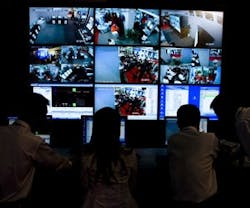During an emergency, the personnel manning your security control center will make life-or-death decisions. The equipment at their workstations, the layout of the center, and the supporting infrastructure must work to help them make split-second decisions. A well-designed security control center isn’t necessarily complex, but it does need a few essential components.
The Workstations
The design of a security control center begins at the central console, a tiered desk that often wraps around the officer in charge. Monitors on the console or wall show video from surveillance cameras trained on key areas of the building. A desktop PC monitors activity on the access control system, and the fire alarm system’s digital readout has a place on the console as well. Many buildings also house building controls here for easy access. Beside the central console, the center should have one, if not two, additional computer workstations.
The computers and monitors for these stations can be PC-based. “You can outfit workstations with PCs, software, and flat panel displays available at Sam’s Clubs and Costcos,” says Don Greenwood, Sr., president of Houston-based Don Greenwood & Associates, Inc. “Some designers today recommend seamless video walls with computer boards and expensive software. But you don’t need that. You can accomplish the same thing today with off-the-shelf equipment.”
Laying Out the Center
The main security console and workstations form the heart of the security center but won’t fill it up. Other key components include a private washroom with a shower and room for changing clothes, a closet for coats and changes of clothes for officers, and desks for others that might be using the room. Many security centers also have small kitchenettes with a microwave, sink, and refrigerator. It’s a convenience for officers on shift and more or less a necessity for those on 24-hour duty.
During an emergency, the security center will accommodate an enormous number of people: security officers, police, firefighters, and others. Plan the center’s square footage with that in mind. If the space is too small, extra bodies can become a hindrance rather than a help.
Ceiling height is also important. If you put six 52-inch monitors on the wall, two up and three across, you’ll need a ceiling at least 10 feet high, says Louis G. Caravelli, CPP, a director of security with Securitas. “You’ll also need enough space to set the workstations back at least 15 feet from the wall to give the operators a comfortable view,” he adds.
Caravelli recommends indirect ceiling lighting with lamps directed toward the ceiling. The reflected light reduces glare, which can make it hard to concentrate on large monitors and desktop computer screens. If that doesn’t provide enough light, Caravelli suggests task lights that officers can adjust themselves. “You should probably check with a lighting consultant,” he adds. “It’s important to get the lighting right.”
Wired telephones and a phone desk large enough to accommodate a number of people have a place in the security center as well. During an emergency, communication with the outside world is essential. One or two of the phones should not go through the building’s exchange but provide plain old telephone service (POTS) that works even when the building’s power goes off and shuts down the building system.
Lastly, “two doors are important,” says Caravelli. “A main entrance that people use most of the time and a second door in case the main door is blocked, such as by fire. The doors need heavy-duty locks with override keys that work when the access control system goes offline.”
Secure Your Infrastructure
Depending on the building and the security risks it faces, the center might need extra strong construction materials. Caravelli suggests metal studs and a layer of plywood covered with drywall. For an added layer of protection, add security mesh.
Since 1995, Mike Fickes has contributed over 200 security articles to publications covering hotel, industrial, office, retail, critical infrastructure, and education. His interests include security management, policies, strategies, and technologies.
The room also needs a raised computer floor to accommodate wiring runs, Caravelli says. He recommends against dropping wires from the ceiling because the assemblies can obscure views of the monitors.
“Put the digital video recorders and other computer equipment into a separate space where you can filter the air and control the temperature,” Caravelli says. “That will extend the life of the equipment. If you don’t have enough room, use computer room filters for the air in the main room. Standard filtration can’t keep the dust and dirt harmful to computers out of the air.”
Make sure you also have enough storage capability to handle today’s increasing requirements. Caravelli recommends enough storage media for 60-90 days of video. For example, slip and fall suits can take 90 days to file.
Overall, the security center needs appropriately sized heating, ventilating, and air conditioning equipment. Choose a system based on the needs of the room when it is filled with people dealing with an emergency.
Just like the building itself, the security center should have fire alarm and suppression systems, including sprinklers in the main room and Halon compressed gas suppression systems for the computer rooms.
Finally, don’t forget power sources. “You should have at least two different power feeds as well as a backup generator,” says Caravelli. “This is vital. This room is the building’s brain during an emergency. It must have power.”
While it is important for you to think about what to put into your center, you should retain an experienced professional to create the actual design. A professional can make more efficient use of space and enable you to make fewer compromises. A security control center is the brain for your building – don’t compromise in ways that limit its capabilities.
